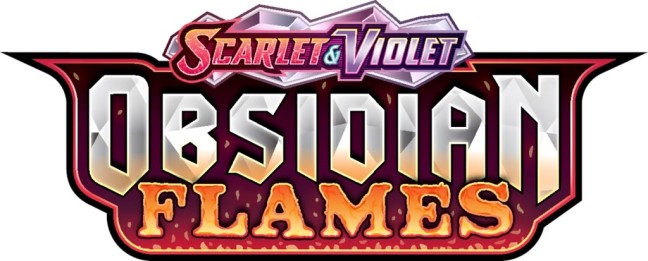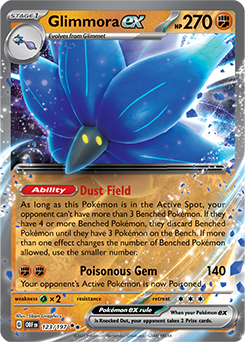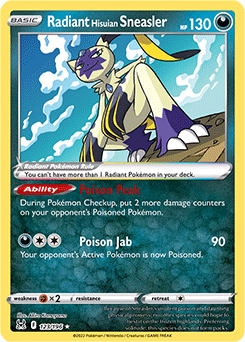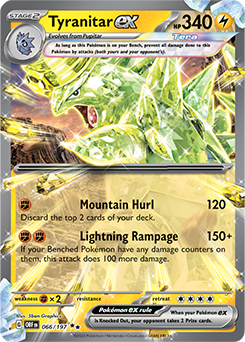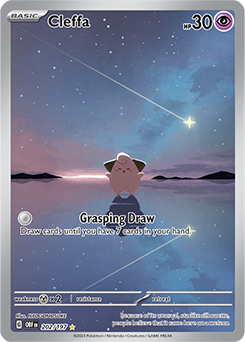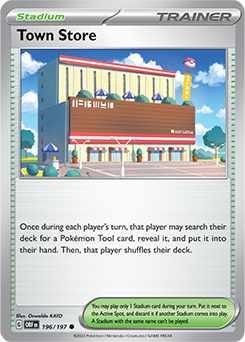Read on below to learn more about one of the latest Pokémon TCG: Scarlet & Violet expansions:
Pokémon TCG: Scarlet & Violet—Obsidian Flames Triple Play
Experts make three decks featuring Pokémon ex that usually fly under the radar: Glimmora ex, Tyranitar ex, and Houndstone ex.
Each Pokémon TCG expansion has one or two strategies that players gravitate toward, but it’s easy to forget that some of the more niche strategies can be just as fun and effective. In the Scarlet & Violet—Obsidian Flames expansion, there is Glimmora ex’s Dust Field Ability, Tyranitar ex’s overwhelming HP and damage output, and Houndstone ex’s powerful Last Respects attack. Each of these Pokémon ex has its strengths, but finding the best way to maximize their potential can be uniquely challenging.
So, we’ve brought in three Pokémon TCG experts and put their deckbuilding skills to the test with another session of Triple Play. Let’s explore how to build three intriguing decks that could start you along your path to peak of TCG play.
Tord Reklev:
Glimmora ex
When figuring out how to build my deck around the new Fighting-type Pokémon Glimmora ex, its Dust Field Ability immediately caught my eye. Whenever Glimmora ex is in the Active Spot, the opponent is limited to only three Benched Pokémon and must discard any Pokémon over that limit. This is essentially the same disruptive effect as one of the most infamous older Stadium cards, Parallel City. Most of the decks in the format depend on a large Bench to function properly, since support Pokémon are so common. The Dust Field Ability forces your opponent to make uncomfortable compromises between their support Pokémon and their attackers.
I wanted to push the disruption narrative the deck already had, with the goal of buying more time to win with Glimmora ex. One of the absolute strongest disruptive cards available in the format is Path to the Peak, but that has obvious anti-synergy with Dust Field. To solve this issue, the newly released Lunatone and Solrock were added to the list. When both are in play, Lunatone’s New Moon Ability protects all our Pokémon from Path to the Peak, allowing us to not only limit the opponent’s Bench, but also turn off Abilities at the same time. Bench space for Lunatone and Solrock is not an issue—we are allowed the full five Bench slots ourselves. Since we are embracing Path to the Peak, it is no longer an option that can be used against us either.
To maximize our disruptive options, I also added four Iono to the deck. Combining three of the arguably strongest disruptive options in the format at the same time makes for a solid strategy: Bench reduction, Ability lock, and hand disruption all at once can pose a major headache for any deck you go up against.
Since Glimmora ex’s Ability only works when it’s in the Active Spot, I figured the easiest way to make that happen was to use it as the main attacker. The 140 damage from its Poisonous Gem attack might not be a ton on its own, but the extra damage from Poison adds up quickly. Also, it makes Radiant Hisuian Sneasler a perfect partner with its Poison Peak Ability. Bringing Poisonous Gem up to 170 damage allows it to threaten a one- or two-hit Knock Out on anything in the format.
Even though we are planning to disrupt the opponent considerably to slow them down and prevent Knock Outs, I figured it would still be a good idea to have some sort of Energy acceleration. This is especially important as Poisonous Gem requires 2 Fighting Energy. Koraidon ex was the first card that came to mind, but I didn’t like how its Dino Cry Ability ends your turn, making it most effective on the first turn of the game. Instead, I added Exp. Share for an extra boost in the unlikely event the opponent manages to deal with Glimmora ex right away before a backup attacker is ready. Gutsy Pickaxe seemed like another natural inclusion—it adds consistency to the deck and it can also accelerate a Fighting Energy in a pinch.
The choice of which Glimmet to use in the deck is an interesting one. All of them have some good merits to them, but I ultimately decided on running four Glimmet with the Ascension attack. With this version, we can potentially get Glimmora ex in play on the first turn of the game and disrupt the opponent right away. The potential downside with this Glimmet is its low HP, which could be taken advantage of by an opposing Sableye that has the potential to Knock Out several of them at the same time. The plan is to set up multiple Glimmora ex before this becomes a problem.
To smooth over the deck’s consistency, I added a Squawkabilly ex and two Lumineon V. There is something immensely satisfying about using these Abilities while Path to the Peak is in play. One of the most common mistakes that happens at all levels of competition is forgetting about an Ability-locking effect, such as Path to the Peak, when trying to play down a Pokémon with an Ability. Thanks to Lunatone and Solrock, we can now safely ignore Path to the Peak at all stages of the game and leave that problem solely to the opponent.
I figured it would be a waste to not have a VSTAR Power available at all in the deck, so I added a Forest Seal Stone as well. This also gives the deck a great way to protect itself from late-game hand-disruption cards like Iono and Roxanne.
Since Glimmora ex has a hefty 3 Retreat Cost, a couple of Escape Rope seemed like a safe inclusion. They can also be used together with Dust Field to create tricky situations for the opponent.
To make sure the deck is as explosive as possible, this list is running four Battle VIP Pass and two Nest Ball. I like having more emphasis on Battle VIP Pass in a build with Squawkabilly ex, as they have great synergy together.
Even though the list features multiple copies of its most important Basic Pokémon, a Hisuian Heavy Ball is included in the cases where the lone copy of Radiant Hisuian Sneasler is in the Prize cards. With 12 total Basic Pokémon in the deck, odds are at least one of them will end up in the Prizes regardless.
I am pretty satisfied with how this list turned out, and I urge you to try this strategy out for yourself! It is a lot of fun and will surely annoy your opponent in a whole new way.
Robin says: I never thought I’d see all those different Rule Box Pokémon in a deck together with four Path to the Peak, but here we are! The combo with Lunatone and Solrock is very cool, even at the cost of keeping these two low-HP Pokémon on the Bench.
I can imagine this list being quite annoying to face even for some of the popular decks. Especially with Fighting-weak Pokémon like Miraidon ex and Arceus VSTAR around, I wouldn’t be surprised if we saw Glimmora ex pick up some wins in tournaments! A card I would try to fit into the list somehow is Rock Chestplate. It could make Glimmora ex even more difficult to deal with for the opponent, for example, putting it out of range for Giratina VSTAR’s Lost Impact attack.
Ross says: I really like Tord’s inclusion of the Lunatone + Solrock + Path to the Peak combo, which should allow Glimmora ex’s Ability to work while also preventing many of the opponent’s Abilities. This combination would be powerful in many decks, but few have the Bench space to use it. Glimmora ex attacks for just 2 Energy and needs little other support, so I do think this could be one of the few decks to pull off that combo.
I would like to see another switching card or two to go with Tord’s two Escape Rope. It seems important for this deck to get a Turn 1 Ascension, or just attack for 140 on Turn 2. It can also be nice to have the option of a switch effect that isn’t Escape Rope, as you may want to hit the current Active.
Robin Schulz:
Tyranitar ex
Tyranitar ex is a Pokémon with impressive stats: its 340 HP is the highest any Pokémon currently has, and its damage output of 250 for just 2 Energy is nothing to scoff at either.
However, there is an additional requirement for Tyranitar ex’s Lightning Rampage to reach that 250 damage: at least one of our Benched Pokémon needs to be damaged. This can happen naturally through the opponent’s attacks, but we can’t always rely on that. So, the first consideration when building this deck should be how to put damage on our own Pokémon. There are a few options in the Standard format, most notably Lucario, Gengar, and Gapejaw Bog. Lucario can act as a useful secondary attacker, but as a Stage 1 Pokémon, is the slowest option of the three. Gengar can be a convenient solution but requires the deck to include multiple ways of getting it into the discard pile.
Ultimately, I’ve decided to go with Gapejaw Bog as my choice, in part due to the second major consideration that presents itself in deck building—the choice of engine. Most decks, especially those with many moving pieces, want to include support Pokémon that let them access more cards throughout the game. Bibarel is a popular choice, but because Tyranitar ex is a Stage 2 deck with access to Rare Candy, I think the new Pidgeot ex fits perfectly. Being able to search the deck for specific cards is generally a more useful effect than being able to draw cards, and Pidgeot ex’s high HP make it more resilient against attacks like Sableye’s Lost Mine.
One downside of Pidgeot ex is that its Quick Search Ability gets shut down by the popular Path to the Peak Stadium card. This is why decks that include Pidgeot ex want to play a lot of their own Stadium cards, which brings us back to the original consideration of Gapejaw Bog versus its alternatives. After deciding on Pidgeot ex as the support Pokémon of choice, Gapejaw Bog becomes not only a way to unlock Tyranitar ex’s extra damage, but also an important card for protecting our engine. For these reasons, it seems like the best inclusion.
A part of the deck list that might look a bit weird at first is the choice of Colress’s Experiment as the main Supporter card. After all, unlike in other decks, there is no payoff for putting cards into the Lost Zone! However, even outside of the Lost Zone engine, Colress’s Experiment is very useful for assembling a specific combination of cards. Since this is a Stage 2 deck, it relies on finding the Evolution Pokémon and a Rare Candy at the same time. If we already have one part of the combo in hand, we don’t want to use a Professor’s Research or Iono to get rid of it. Looking at the top five cards and hopefully finding the missing piece there is much preferred!
Of course, Professor’s Research and Iono are still very strong cards, especially when being able to search for them when needed, so they are in the deck as well. Another important Supporter card is Raihan, which helps the deck in two ways: Tyranitar ex can attack for 1 Energy and do decent damage. Most of the time, we want to attack with Lightning Rampage, so the extra Energy is very useful when falling behind on regular Energy attachments. Secondly, the deck is very reliant on finding Rare Candy early. There are four in the deck, but even so, it can be difficult to draw into sometimes. Thus, searching for it directly is very handy.
Another card that’s in here to help with setup is Mew. Ideally, we want to find Battle VIP Pass on the first turn and Rare Candy on the second turn. Mew’s Mysterious Tail Ability makes this much more likely to happen, and it’s also an additional Pokémon that can be used to take the damage from Gapejaw Bog.
As is usually the case, in addition to all the core and consistency cards, we want some tech cards that interact with other decks. Manaphy is an obvious one to protect our Benched Pokémon from the likes of Radiant Greninja. As a Tera Pokémon, Tyranitar ex itself is protected from Bench damage, but our smaller Pokémon still need the support! Choice Belt is another easy inclusion: it allows Tyranitar ex to Knock Out popular Pokémon with 280 HP like Arceus VSTAR or Giratina VSTAR. Switch can be situationally useful because of Tyranitar’s massive Retreat Cost, and it’s also a good card to draw early on to switch a Mew in or out.
Lastly, there’s the Darkness-type Tyranitar. Since we don’t need any other Special Energy cards, Luminous Energy fits into the deck without much issue and gives us access to the Rout attack. Pokémon that are weak to Darkness like Gardevoir ex and Mew VMAX are currently very popular, so having an attacker that’s able to KO them in one attack can be very valuable!
One of the great aspects of playing a deck with Pidgeot ex is being able to find specific tech cards at exactly the correct time, so make sure to experiment with different options during deck building.
As a general tip for playing the deck, you should usually prioritize Pidgeot ex. After using a Rare Candy to evolve into it, you can immediately search for a second Rare Candy to use on Tyranitar ex, which is way more efficient than doing it the other way around. The importance of Quick Search for this deck cannot be understated, so make it your first goal of the game to get Pidgeot ex into play.
Also keep in mind that since Tyranitar ex is a Lightning-type Pokémon, it hits opposing Pidgeot for Weakness. Make sure to reach for those Boss’s Orders as fast as possible if matching up against one of them!
Tord says: I really like the decision of using Pidgeot ex as the choice of engine for this deck—it has great synergy with the Rare Candy cards that are already mandatory for the list. Stage 2 Pokémon are more difficult to set up, but the payoff is worth it. Historically, the Stage 2 decks that have performed the best have had multiple options for the final Evolution in a Pokémon line. The inclusion of the Darkness-type Tyranitar can give this deck that little extra boost needed to push it over the top and become a real threat, especially against the popular Mew VMAX and Gardevoir ex decks.
Ross says: Robin’s choice to go with a Pidgeot ex engine for Tyranitar ex is interesting to me. On the surface, Tyranitar ex with no Ability of its own looks like a good deck to play Path to the Peak in, or perhaps just play few Stadiums if you can safely ignore other players’ Path to the Peak. Stage 2 Pokémon are always difficult to set up throughout a game, however, especially without a superb Stage 1 card like Kirlia. So, perhaps Robin is right that Pidgeot ex is the way to go.
Given the importance of Choice Belt and Rare Candy in this deck, I wonder if an Arven card could be worth a spot. If you played this, you could also consider adding Lumineon V and Forest Seal Stone since the deck is already playing Ultra Balls.
Ross Cawthon:
Houndstone ex
Every time a new Pokémon TCG set comes out, there are cards that are obviously strong and many others that make you wonder whether you could make them work. One type of card that always catches my eye are Pokémon that can do essentially infinite damage. If you just do “Y,” you can one-hit Knock Out anything! Of course, “Y” is often quite difficult and complicated. One such card from earlier this year was Houndstone from the Scarlet & Violet expansion. If you get 20 or more Psychic-type Pokémon in the graveyard discard pile, Houndstone’s Last Respects can take down even the bulkiest Pokémon! But that of course is quite difficult to pull off when you consider you need the right Pokémon in play, Trainers, and Energy cards.
Well, it’s almost like the universe decided to throw me a bone with the new Houndstone ex from Scarlet & Violet—Obsidian Flames. It’s a challenging card to build around, but I decided to take a bite.
The first step to building around Houndstone ex is figuring out what Psychic-type Pokémon to play, because you need a lot of them to fuel the Last Respects attack. After trying a few different lists, I settled on Pokémon that maximized my board setup. After all, we can’t play the usual amount of Trainer cards most decks can.
Zacian V is a great card to get an extra Energy on the field immediately. Even just one use of the Roar of the Sword Ability to get an Energy on a Greavard helps you continue your attacks throughout the game. Almost as importantly, I wanted some Pokémon V to allow me to use Forest Seal Stone, effectively adding more ways to find Professor’s Research (or anything else I might need). Galarian Articuno V is another Pokémon V that can use Forest Seal Stone, and its Reconstitute Ability fits the deck well, letting me discard two cards from my hand to draw one.
Meowstic’s Inviting Ears Ability gives you another way to find Professor’s Research. This card has seen far less play in the Standard format than Lumineon V (which has a similar Ability), but when you need to play a lot of Psychic-type Pokémon anyway, even a Stage 1 that finds a Supporter just one time becomes useful. I typically only use at most one Meowstic per game, discarding the other Espurr and Meowstic cards.
Cleffa is a beautiful new card that also has a free Grasping Draw attack, which can let you draw several cards in a tight spot. However, Grasping Draw is really just for emergency use, as I want to use Zacian V’s Roar of the Sword Ability on my first turn instead. What I like most about Cleffa is that it has a free Retreat Cost, a rarity on a Basic Pokémon in the Standard format. This really keeps your gameplan flexible if you start with it; you can either use Grasping Draw, or retreat easily to begin attacking with Houndstone ex on Turn 2. Normally playing four of a card just because it has free retreat represents a major commitment to your deck. In this deck though, the other three copies of Cleffa aren’t a waste—you’d gladly put them in the discard pile for Houndstone ex’s Last Respects.
The final Pokémon I’ve added is Radiant Alakazam. This card has been one of the most prominent Psychic-type Pokémon in the game lately, appearing in the deck that won the North America International Championships Masters Division. Its Painful Spoons Ability is particularly good against the Gardevoir ex deck that took second place at the World Championships. Radiant Alakazam combos well with the new Vengeful Punch card from Scarlet & Violet—Obsidian Flames, which puts 4 damage counters on a Pokémon that Knocks Out your Pokémon. This combination of cards gives you a strategy to get some wins against the Gardevoir ex deck, and it can help you out occasionally in other spots. You can even use Houndstone ex’s Big Bite attack to keep something like a Mew Active and then move the damage off with Painful Spoons. In other matchups, you can just discard Radiant Alakazam to boost Last Respects.
When it came to Trainer cards, I embraced a bare-bones mindset. Because of the high number of Pokémon that are included in this deck, we can’t play the Trainer cards we usually would. Thus, Professor’s Research ends up being the main draw. The cost of having so many Pokémon is also having fewer Pokémon search methods available, so I only added Fog Crystal, which is invaluable as a means to get Psychic-type Pokémon or Psychic Energy. There’s just no room for cards like Nest Ball or Ultra Ball. I do play Hisuian Heavy Ball: it is pretty critical to include four Greavard in case one gets Knocked Out early.
As mentioned, Forest Seal Stone is a key card to help you get Professor’s Research. The Scarlet & Violet—Obsidian Flames card Town Store is a way to find it, along with our other tools, Vengeful Punch and Exp. Share. PokéStop is also a good Stadium to aid in discarding more Pokémon. That’s also the main reason Trekking Shoes fits here, helping you find the cards you need in hand.
In trying a few things with the deck, I realized that while attacking for a ton of damage late was the goal, it’s equally important to start attacking early—as soon as Turn 2 if possible. To facilitate attacking quickly (and effectively), I kept two Switch and three Boss’s Orders. An early Boss’s Orders can just stomp an opponent with a below-average setup. While the deck is designed to get one-hit Knock Outs late, you want to be sure you can attack on Turn 2 to put pressure on your opponent. You can’t just fall behind in Prizes while you’re building your discard pile. Similarly, having four Double Turbo Energy maximizes your chances of a Turn 2 attack.
Houndstone ex leads to interesting deck construction, and several other new cards from Scarlet & Violet—Obsidian Flames ended up making my final list. This deck can still be hit-or-miss with the limited Trainer cards it plays, but doing 300+ damage by the end of a game is not rare. Plus, you can get a head start on Halloween by spending time with this loyal gravekeeper!
Tord says: From a deckbuilding perspective, some of the absolute most fun decks to build are the ones where your deck is focused on getting a lot of Pokémon in the discard pile. In the past, I loved playing with Vespiquen‘s Bee Revenge and Flareon‘s Vengeance. Doing so opens up a lot of room for creativity, since you can use heavy lines of Pokémon for support instead of Trainer cards. I really like what Ross has done here with this list; the inclusion of Meowstic is especially clever. Decks like these will usually leave hands clogged with a ton of Pokémon, and Professor’s Research is the card you will be looking for most of the time.
Robin says: Looking at Houndstone ex, I expected it to be paired with Kirlia and Gardevoir ex, due to their obvious discard synergy and Energy acceleration. However, I’m not surprised to see Ross decide on a completely different and more creative build! It reminds me a bit of his Top 4 Vespiquen deck from the 2016 World Championships. These strategies that slowly build up the discard pile for a huge payoff in the later parts of the game have always been some of my favorites, so I have to say this deck looks very fun to play! Even more so than similar decks in the past, this build really gives a different perspective on deck building due to the high focus on Pokémon over Trainer cards. I would have liked to see at least a few Ultra Ball listed, but it does indeed look difficult to fit everything in.
For more Pokémon TCG strategy and analysis, visit Pokemon.com/Strategy.

Tord Reklev
Tord Reklev is a contributing writer for Pokemon.com. He is a longtime player from Norway, playing the game since he was 6 years old. In becoming Champion at the 2022 Latin America International Championships, Tord is the first player to win all four International Championships and complete the Grand Slam. Outside of the game, he is a student and enjoys playing tennis. You can find him at most big events and can follow him on Twitter at @TordReklev.

Robin Schulz
Robin Schulz is a contributing writer for Pokemon.com. He has been competing in Pokémon tournaments for 10 years and was the Pokémon TCG Masters Division World Champion in 2018. He spends a lot of time traveling and competing, and he rarely misses a big event. Aside from playing Pokémon, he attends university, where he is studying mathematics.

Ross Cawthon
Ross Cawthon is a longtime player, starting to play tournaments in 2000. He is the only player to compete in all 19 Pokémon TCG World Championships, finishing as a finalist in 2005 and 2011, and a semifinalist in 2016. He is known for creating many new “rogue” decks over the years. Ross has a Ph.D. in astrophysics and studies dark energy (not to be confused with Darkness Energy cards).
Source: Pokemon.com

